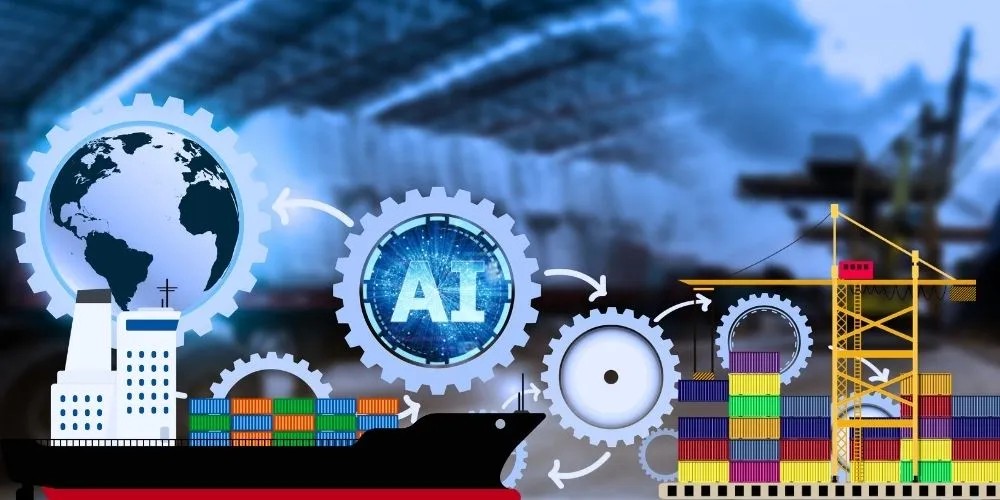In the fast-paced world of global commerce, the intricacies of supply chain management have taken center stage. As businesses strive to enhance efficiency, reduce costs, and respond to dynamic market demands, a formidable ally has emerged: Artificial Intelligence (AI). Integrating AI in supply chain optimization reshapes the logistics landscape, redefining how goods flow from producers to consumers. As we delve into AI-driven supply chain optimization, we uncover its transformative impact, challenges, and potential to usher in a new era of efficiency and resilience.
A Symphony of Data and Intelligence
At its core, AI in supply chain optimization harnesses the power of data analysis, machine learning, and predictive modeling to streamline every facet of the supply chain. These intelligent systems process massive amounts of data from various sources, including suppliers, manufacturers, warehouses, and market trends. By identifying patterns, anomalies, and opportunities for improvement, AI systems provide decision-makers with actionable insights that enhance the efficiency and effectiveness of supply chain operations.
AI’s role in supply chain optimization extends beyond data analysis. Machine learning algorithms can predict demand fluctuations, enabling companies to adjust inventory levels accordingly. Natural language processing capabilities facilitate real-time communication and stakeholder collaboration, minimizing delays and improving responsiveness.
AI in Supply Chain Optimization’s Influence
The impact of AI in supply chain optimization is far-reaching, touching every step of the logistics process. From procurement and inventory management to transportation and distribution, AI-powered systems bring efficiency gains that redefine the speed and precision of supply chain operations.
For example, AI algorithms can optimize route planning for delivery trucks, considering traffic, weather conditions, and delivery windows. This results in shorter transit times, reduced fuel consumption, and minimized operational costs.
In inventory management, AI-driven demand forecasting improves the accuracy of predicting which products will be in demand and when. Businesses can avoid overstocking or stockouts by optimizing inventory levels and reducing carrying costs while ensuring product availability.
Challenges and Considerations
While the potential of AI in supply chain optimization is substantial, it also presents challenges that must be addressed. One critical concern is the quality of data. AI systems heavily rely on accurate and comprehensive data to make informed decisions. Poor data quality can lead to erroneous predictions, resulting in supply chain disruptions and inefficiencies.
Ethical considerations also come into play. As AI systems impact various stakeholders, ensuring those decisions are ethical and responsible is crucial. Striking the balance between automation and human judgment and adhering to ethical standards is essential.
The Future of AI in Supply Chain Optimization
As AI in supply chain optimization continues to redefine logistics, several strategies can ensure its potential is maximized while challenges are navigated. Data governance and quality assurance are paramount. Organizations must invest in data collection, validation, and cleansing processes to ensure that AI systems make accurate decisions based on reliable information.
Interdisciplinary collaboration is pivotal. Supply chain professionals, data scientists, AI experts, and business leaders should collaborate to ensure that AI systems align with operational needs, industry regulations, and ethical standards.
Education and upskilling are essential. Employees involved in supply chain operations should be equipped with the knowledge and skills needed to leverage AI tools effectively. It empowers them to make informed decisions, interpret AI-generated insights, and collaborate seamlessly with intelligent systems.
The influence of AI in supply chain optimization extends beyond logistics. It redefines business strategies, enhances customer experiences, and strengthens global commerce. However, the journey forward requires carefully balancing data quality, ethical considerations, and human oversight.
Conclusion
As we venture into the future of logistics, AI in supply chain optimization emerges as a transformative force. It empowers organizations to navigate complexities, streamline operations, and swiftly respond to market dynamics. The fusion of data-driven insights and intelligent automation offers a pathway to efficiency, resilience, and customer satisfaction.
In the evolution of supply chain management, AI catalyzes innovation. By embracing data-driven decision-making, nurturing interdisciplinary collaboration, and adhering to ethical principles, businesses can unlock the potential of AI in supply chain optimization, paving the way for a future where logistics transcend boundaries, inefficiencies are minimized, and the supply chain becomes a strategic asset in the pursuit of sustainable success.












